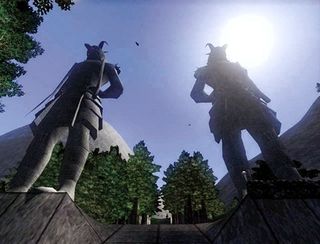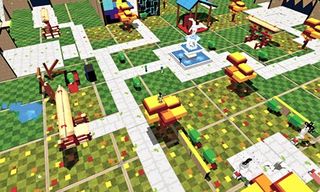It’s the third in our triumvirate that really makes the most of user-generated content, however, and that’s the teeming world ofWurm Online. One of Wurm’s co-creators, Rolf Jansson, explained how the idea of letting players leave a permanent mark on their world had always been at the heart of the project. “The importance of being able to affect your surroundings should lie at the heart of every game,” he says.

“We were frustrated with how little impact we could have on other games and their environments. People only feel they belong somewhere if they can make their mark in a simple, straightforward, easy to understand way – flattening a bit of land and sticking a sign on it saying ‘this is my home’ is about as simple as you can get. You don’t need to be a graphic artist or a computer programmer, you just need to want to belong. Add another 500 people trying the same thing and you no longer have a game, you have a culture.”
For Jansson the opportunity was to make a virtual world, a culture, something analogous to the real world. His colleague Joss Sanglier explains what this means. “Because people have to do common tasks to be able to live in the world of Wurm, you have exactly the same set of common starting points. Everyone still needs to hunt, farm, build houses, chop trees, make tools and so on. And of course, the best way of doing all this is to do it together.”

All three games have this last point in common: they’re ways for us to live and work together that are like extensions of the way we live and work together in the real world. They’ve realised that the only thing more interesting than videogames is other people. Combine what’s best about both and, well, you have a genuine recipe for success.
Your new homes
These indie massively multiplayer games put the capacity to make real change into the hands of their players. These experiments show the power of PC developers to push back the boundaries of online gaming.
A painted landscape

Love’s impressionistic views are dominated by the settlements. Often atop mountains for defence, they’re furnished with the collected monoliths and token-dispensers brought in by players from across its strange globe.
A psychedelic LEGO town

Neverdaunt’s building is all about primary colours and platonic shapes. Not that you can’t create some fairly radical things with these tools. It’s the kind of bonkers construction kit that many people would associate with LEGO.
A brutal fantasy world

Wurm’s virgin hills and mountains have been permanently scarred by the appearance of mankind. Much like the real world, the changes made by players are persistent. Forests are flattened, buildings remain in an allegorical lesson for the real world.
May 12, 2010


PC Gamer's top 100 PC Games of all time
A century of brilliant games

7 upcoming MMOs you need to know about
The most promising online worlds waiting to be explored

The lost PC games you'll never play
Witness the last gasp of potentially great canceled games
